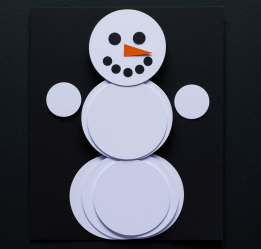Snowy Words - Building Literacy Skills with Snowman Fun!
EYFS Literacy and Snowman Activity
The Early Years Foundation Stage (EYFS) literacy framework is fundamental in cultivating young learners' reading and writing skills. By integrating playful and thematic activities, educators can make literacy learning more engaging and effective. One such activity is snowman building, which combines the magic of winter with essential literacy skills development. This activity is designed to capture children's imaginations while simultaneously enhancing their letter recognition and word formation abilities.

Engaging pupils through seasonal activities like building snowmen not only stimulates their creativity but also solidifies fundamental literacy concepts in a memorable way. The snowman activity provides a wonderful opportunity to blend physical interaction with cognitive learning, making literacy education both enjoyable and impactful. By focusing on forming three-letter words, this exercise specifically targets early phonetic understanding, offering a foundation for future linguistic success.
Materials Needed for the Snowman Literacy Activity
To execute the snowman literacy activity, you'll need some basic materials:
- Black card,
- white card circles, with black letters on them
- Orange card (to create the snowman’s nose)
- and glue.
The black card serves as a striking backdrop, enhancing visibility and focus on the snowman heads glued at the top.
White card circles with letters are used to compose simple three-letter words, and these should be cut out beforehand.
These materials are not only inexpensive and easily accessible but also perfectly aligned with the activity's objectives of simplicity and creativity in learning. (Feel free to jazz up the materials with a little glitter, or perhaps some pompoms to represent snow!)
Setting Up the Snowman Literacy Activity
Begin by preparing your black card with snowman heads securely glued at the top, ensuring each child has a clearly defined workspace. Arrange the white card circles with various letters in a way that invites exploration and interaction. Make the setup visually appealing to capture and maintain the pupils' attention, which is key to fostering an engaging learning environment.
Consider setting up the activity in a way that encourages children to explore independently or in small groups, depending on your classroom dynamics. If you’d like the lesson to be more active, place different letters on different tables and encourage children to find the letters they want.
It’s crucial to ensure that the setup promotes a conducive learning atmosphere where students feel encouraged to experiment with different letter combinations and word formations. This will help them build confidence in their literacy skills.

How to Conduct the Activity
Guide your pupils through the activity by explaining the goal: to build a snowman by forming three-letter words using the lettered circles. Encourage them to choose letters that create meaningful words and place those circles in sequence under the snowman heads. Offer support and guidance as needed, while fostering an atmosphere of curiosity and creativity.
It’s important to adapt the activity to suit different learning paces. Some children may grasp the concept quickly and move on to more complex words, while others might need additional encouragement and time to experiment with letter combinations. Tailoring your approach will ensure that every student can benefit from the activity at their own pace.
Examples:
Examples of simple yet educational three-letter words include CAT, BAT, MAN, WIG, and WAG. These words not only introduce basic phonetic principles but also help in expanding the students' vocabulary.
For some christmas themed words, you could use simple four letter words such as STAR, TREE, WISH, BELL, GIFT, SNOW, NOEL etc.
Encourage pupils to think creatively and come up with their own words, fostering a sense of achievement and ownership over their learning process. This initiative nurtures early literacy by linking phonetic understanding with word creation.
Encouraging Teamwork and Collaboration
Promoting teamwork within the activity can have significant benefits for both literacy and social skill development. Encourage pupils to work in pairs or small groups to create words and build their snowmen together, facilitating a shared learning experience. Collaborative tasks such as these help children learn from one another, share ideas, and develop communication skills, which are essential in both educational and personal development.
Benefits of the Snowman Literacy Activity
The snowman literacy activity offers a myriad of benefits, beginning with enhanced literacy skills. By engaging in this playful task, children develop a better understanding of letter sounds and word formation, foundational elements of literacy education. Additionally, the activity helps refine fine motor skills as pupils handle and arrange the small card circles.
Moreover, the snowman activity fosters a positive attitude towards learning by presenting literacy in an enjoyable and relatable context. Such activities can inspire a lifelong love of learning, encouraging children to associate education with fun and discovery. By making literacy exciting, educators can instil motivation and enthusiasm in their pupils.
Aligning with EYFS Literacy Goals
This snowman activity is well-aligned with EYFS literacy standards, supporting early literacy development effectively. It encourages recognition of letter sounds, promotes phonetic awareness, and helps children practice creating simple words, all of which are key EYFS objectives. As pupils progress, teachers can track their achievements and recognise improvements, reinforcing the value of these activities in the learning journey.
Top Tips
To maximise engagement, consider varying the activities to include different themes or challenge levels. Address common challenges by being patient and offering positive reinforcement to hesitant pupils. Encouragement and creativity in your teaching approach can transform a standard literacy task into an exciting educational adventure. Flexibility is also crucial, allowing you to adapt the activity according to the unique needs of your classroom.
Conclusion
In conclusion, the snowman literacy activity merges the joy of winter with valuable educational outcomes. It provides an engaging way to enhance literacy skills while fostering teamwork and creativity among young learners. Educators are encouraged to explore and innovate with further literacy activities, constantly seeking new ways to make learning both effective and enjoyable. Let this snowman activity be a springboard for encouraging a lifelong passion for literacy in every child.
Looking for more fun literacy lesson plans?
Fun with Phonics Buttoned-Up Letters
7 Creative Ways to Incorporate Mighty Writer into the Day
